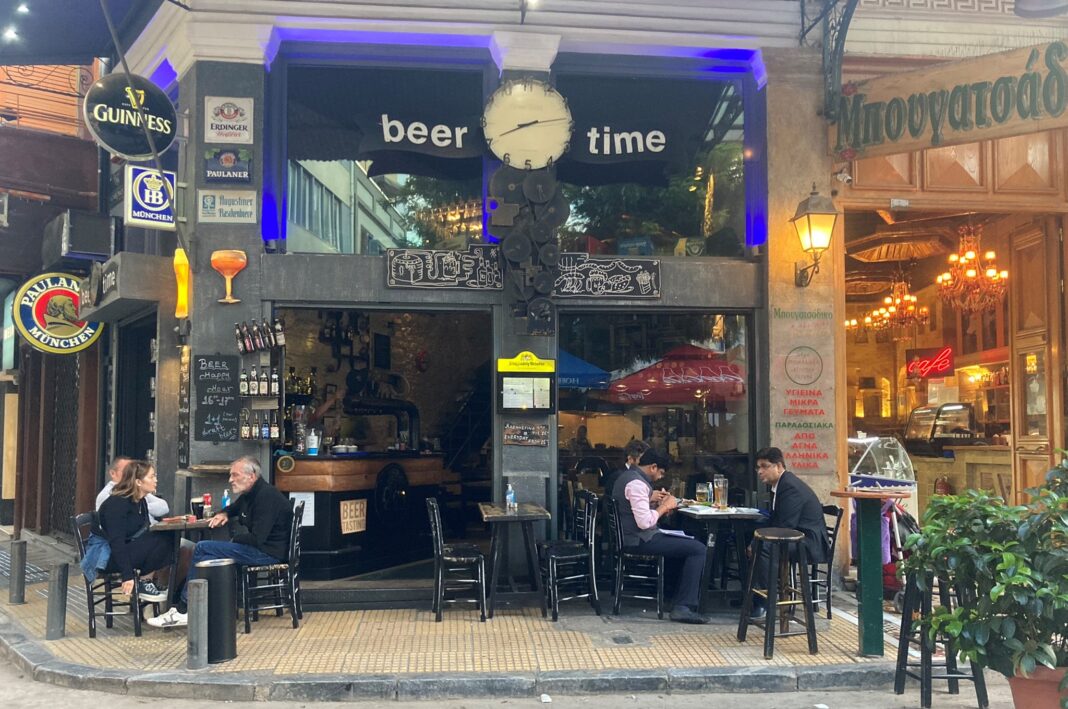 I was dining on pastitsio and kebabs at the estimable Beer Time pub in Athens (cover photo), and washing them down with a selection of Greek craft beer, when it suddenly occurred to me that twenty years ago I passed the Beer Judge Certification Program (BJCP) test.
I was dining on pastitsio and kebabs at the estimable Beer Time pub in Athens (cover photo), and washing them down with a selection of Greek craft beer, when it suddenly occurred to me that twenty years ago I passed the Beer Judge Certification Program (BJCP) test.
This milestone was attained much to the shock and consternation of those helping to administer the exam locally, as it included hefty components of brewing science and chemistry, which everyone knows I’ve always joyfully neglected in favor of telling stories about finding a clean, well-lighted pub somewhere in Belgium where the owner disappeared into a cellar and emerged covered with cobwebs and holding a bottle of decade-old mead.
(It really happened, and the mead was outstanding.)
But science and chemistry? Me? Nah, I’d rather bale hay in high summer the old-school way, plunge knitting needles into my eyes, and then trundle off to dine at Ronnie Mac’s.
The odds against me were daunting, so how on earth did I manage to pass the BJCP test?
Most importantly, I was almost perfect on the questions about beer styles and history. Then, when I saw those impossible science and chemistry questions, I just ignored them and kept on writing about beer styles and history.
Someone at BJCP Central HQ must have appreciated my cheek, because I was awarded just enough credit to squeeze through with a bare minimum score of 70.
I’ve indulged in beer judging only a handful of times since. Although I support the cause and believe it to be valuable, it remains that by the conclusion of most soul-crushing weeks, I’d rather slip out to the veranda to unwind with a nice glass of Vienna lager and a tin of kippers, and leave the scoring of beers to others.
I perfectly understand that beer judging isn’t everyone’s cup of Koduõlu (an Estonian-style farmhouse ale), but if one wishes to properly evaluate a beer absent a formal brewing competition’s meticulous standards—admittedly, they can sometimes resemble an operating theater’s hygienic procedures at your local hospital—there remain certain ground floor preconditions.
- You should refrain from the sort of palate corruption that comes from shots of Fireball, pinches of smokeless tobacco, or whole bulbs of roasted garlic ingested prior to tasting the beer (or, alas, even a tin of kippers).
- The beer itself should not be “the coldest in town” or iced to the point of glacial, unless you’re considering an American low-calorie “light” lager, in which case chill-induced flavorlessness is a purposeful redundancy that actually reinforces the style’s essential futility.
- What’s more, the beer must be poured into a glass, preferably clean, because not only is it semi-barbaric to chug beer from a bottle or can, but doing so deprives the taster of critical olfactory qualities.
Lastly, and for me representing the hill I’m prepared to lie on (c’mon, “dying” seems overly extreme): When “officially” judging a beer under ideal conditions, blind tasting is absolutely paramount.
Beer judges are told what style the particular beer represents, and that’s it. They must view, smell, taste and swallow the beer without being influenced by external factors, while never forgetting that spitting is for those uncouth wine arbiters.
Blind tasting is important in beer judging because the human brain is forever keen to muddle objectivity with extraneous prejudices, and among these are labels, logos and packaging. Simply stated, even when we understand the way marketing techniques are deployed to play tricks on us, we still fairly beg to be fooled, and once such chicanery is afoot, it’s fiendishly difficult to avoid being duped.
Humans have lots of buttons, and sales people a great many fingers. They don’t hesitate to use them, because that’s how they get paid.
Yet at the end of the day, it is a beer we’re drinking, not beer marketing. That’s why judges sample beers from which the marketing has been scrubbed as thoroughly as possible.
—
Fortunately the practice of blind taste testing needn’t be restricted to formal beer judging venues. It’s also a valuable antidote to “hot takes” like this one, which I see painfully often on social media:
“After all, there’s a time and place for an ice cold Miller High Life or Pabst Blue Ribbon or Coors Banquet or Hamm’s.”
No.
There isn’t.
Not if you’re actually beer-literate and should know better, as there is no compelling reason to flatter retro Americana (or heritage, or legacy) lagers of the boring sort that made our better beer revolution necessary in the first place.
But first, to preserve my egalitarian credentials and forestall abuse, kindly note that in the critique to follow I’ll be omitting the general beer drinking public, precisely because this segment of the populace doesn’t give a tinker’s damn about beer literacy, better beer or beer revolutions.
Rather, Joe and Josephine Six Pack regard beer as a commodity, like milk or Mountain Dew, and when beer need be no more special or unique than an ice-cold alcohol delivery device for washing down pizza or barbecue and altering one’s consciousness, and it is consumed without beer knowledge or pretenses about its consumption, then who can complain? The ensuing transaction is 100% honest and hypocrisy free.
Consequently beer consumption like this lies entirely outside my bailiwick, and I have no qualms with any of it. May Joe and Josephine Six Pack live long and prosper. Modelo sales have continued to skyrocket.
Yay, America.
But what if you do know better? Then what?
In order to answer these questions, consider the extent to which these utterances rely on perceptions shaped by sight, not flavor. When a celebration of High Life or PBR emanates from a person engaged in the business of brewing and vending craft beer, there’ll almost always be an accompanying photo of the can or bottle for embellishment, but seldom an image of the beer as poured into a cup or glass.
Because: A cup or pint glass without a prominent logo is lacking the Pavlovian visual cue necessary to elicit the desired reaction, namely, “hell yeah there’s a time and place for this.”
But again, this reaction is about the eyes, not the mouth. It’s about appearances, not essences. Put these retro Americana (or heritage, or legacy) lagers to a blind taste test, and there can be only one conclusion: cheap pet shampoo, although Fido is probably less likely to be bamboozled by the packaging than his owner.
I hate to shatter your illusions, but the goosebumps are all about the marketing, not the liquid in the can. We’re expected to see the ancient PBR logo and feel a sudden onrush of nostalgic memories, like Dennis Hopper in that senseless movie, or maybe by recalling bygone days on the lake with grandpa when everyone fished, smoked, farted and pounded Banquets.
To repeat, these marketing prompts have nothing to do with the beer in question, because otherwise we’d plainly recall how foul PBR tasted way back then (trust me), only to be revived more recently as the polar opposite as a beer entirely lacking flavor of any sort. Drink a Hamm’s without Comrade Pavlov’s assistance (or at a higher price point), and you’ll be making a justifiable beeline for Pilsner Urquell, or probably even Yuengling in spite of the old man’s campaign donations.
Either way, preconceptions having nothing to do with the actual beer we find bizarrely cascading down craft beer biz gullets somehow manage to convince these otherwise beer-savvy peeps to ignore the sheer insipidity of the liquid they’re swallowing.
It baffles me when otherwise adept craft beer practitioners exonerate flavorless mass-market lager. The cultural braggadocio strikes me as flailing (no, really, it does taste great) as well as self-defeating, given that the majority of them earn their pay by selling beer (or wine, or spirits) that occupy a price tier more dear than Miller High Life or Pabst Blue Ribbon or Coors Banquet or Hamm’s.
Price point comparisons suggest a whole other rant, so while I’m here and suitably agitated, allow me to indulge.
—
Some years back while perusing social media, imagining that being clubbed senseless with a slab of semi-frozen whale blubber would be a better use of my time, I noticed a blurb from a local eatery with a better-than-average bar program.
“Cheap beer is coming,” trumpeted the post, along with a photo of an ice cold can of Hamm’s in full retro regalia.
It made me think of the many times I’ve seen breathless announcements for “cheap wine”—except I’ve almost never seen them. Half-price bottles on Wednesday, perhaps, but never the word “cheap.”
Why would you do that when you’re trying to sell representative, full-priced wine every other day of the week?
Contemporary cocktail-driven bar programs seldom advertise on the basis of “cheap” whiskey, either. Phrases like “rotgut hooch combined with the least expensive mixers” simply doesn’t feed (or water) the bulldog, even if those half-pints of Kessler still fly from package store shelves to lube the paper sack crowd, especially on election morning.
Yep, it’s invariably top-shelf and upscale with on-premise wine and spirits, but when it comes to beer, the misplaced glorification of dumbing it down (in the name of what, exactly?) always seems to be lurking just around the corner, breathlessly waiting for someone who knows better to venture a hot take just like “there’s a time and place for pounding this dreck.”
To repeat, secure in the knowledge that it won’t make me any friends, but sorry.
No.
There isn’t.



















 Roger Baylor is an educator, entrepreneur and innovator with 40 years of hands-on experience and expertise as a beer seller, restaurateur and commentator. As the co-founder of New Albany’s Sportstime Pizza/Rich O’s Public House (which later became New Albanian Brewing Company) in the 1990s and early 2000s, Baylor played a seminal role in Louisville’s craft beer renaissance. Currently he is the beer director at Pints&union in New Albany and Common Haus Hall in Jeffersonville. Baylor’s “Hip Hops” columns on beer-related subjects have been a fixture in F&D since 2005, and he was named the magazine’s digital editor in 2019.
Roger Baylor is an educator, entrepreneur and innovator with 40 years of hands-on experience and expertise as a beer seller, restaurateur and commentator. As the co-founder of New Albany’s Sportstime Pizza/Rich O’s Public House (which later became New Albanian Brewing Company) in the 1990s and early 2000s, Baylor played a seminal role in Louisville’s craft beer renaissance. Currently he is the beer director at Pints&union in New Albany and Common Haus Hall in Jeffersonville. Baylor’s “Hip Hops” columns on beer-related subjects have been a fixture in F&D since 2005, and he was named the magazine’s digital editor in 2019.


